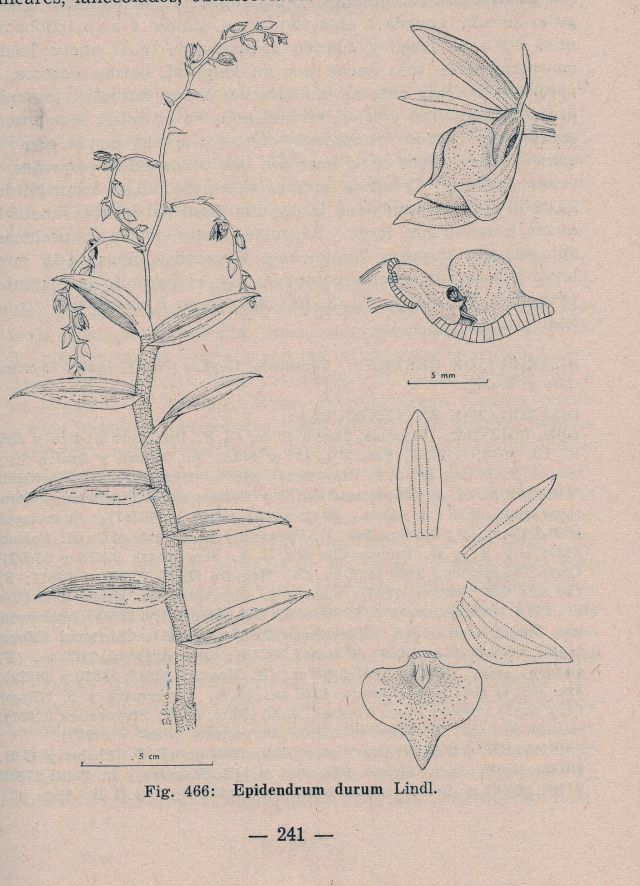

Epidendrum durum Lindl. 1841 GROUP Aquaticum
Drawing by © Foldats



Common Name The Hard Epidendrum
Flower Size .2" [5 mm]
Found in the West Indies, Venezuela, Guyana, and Brazil on sandstone outcrops or in boggy situations at elevations of 1350 to 2600 meters as a giant sized, cool to cold growing terrestrial or lithophyte with ascending, erect to slightly arching, simple to branching, basally terete, somewhat compressed above, leafy in the apical half stems carrying rigid, fleshy, distichous, erect to erect spreading, linear-oblong, oblong lanceolate, lanceolate, lanceolate ovate to ovate, acute to obtuse leaves that blooms on a terminal, erect, arching to rarely pendent, paniculate to rarely racemose, 1.2 to 6.8" [3 to 17 cm] long, few to many flowered inflorescence with fleshy, spreading, very concave, cucullate, ovate, obtuse to acute, shorter to as long as the ovary floral bracts and carrying coriaceous-fleshy, yellow to greenish yellow to green flowers.
"Epidendrum durum Lindl. is part of GROUP Aquaticum Characterized by the monopodial, branching habit, the distichous, erect inflorescence, with fleshy flowers, and the disc of the lip and/or nectary often pilose. The species is an intermediate sized plant, to 22.4" [56 cm] tall, the leaves lanceolate, .8 to 1" X .2 to .56" [2.0 to 2.5 x 0.5 to 1.4 cm] long inflorescence racemose to paniculate, when paniculate the racemes spreading at a 90° angle with the axis, flowers small, greenish white, sepals .26 to .28" x .12 to .16" [6.5 to 7 x 3 to 4 mm], and petals linear-elliptic. E carnosum Lindl.recognized by the large plants, to 50" [125 cm] tall, lanceolate leaves, acute, the margin spreading, 1.6 to 3.46" [4.0 to 8.6 x 0.6 to 1.3 cm], the inflorescence is usually paniculate, branches sub-erect, nearly parallel to the main axis, sepals .36 to .4" [9 to 10 mm] long, petals .32 to .36" x .6 to 1" [8 to 9 x 1.5 to 2.5 mm], lanceolate-rhombic, and the lip .24 to .32" x .44 to .48" [6 to 8 x 11 to 12 mm] has a single callus with the apex bidentate. Epidendrum ulei Schltr. has similar large-sized plants, 18" to 32" {64"} [45 to 80 {160} cm], but the leaves are oblong with the apex rounded and the margin somewhat revolute, 1.2 to 2.8" x ,36 to 1" [3 to 7 x 0.9 to 2.5 cm] long inflorescence, paniculate with the racemes spreading from the axis, sepals similar in size, .36 to .4" x .136 to .2" [9 to 10 x 3.4 to 5.0 mm], and the petals linear, lip bicallose, the calli thin, converging at the apex. Epidendrum pseudavicula Kraenzl. has very short plants, 2,8 to 7.2" [7 to 18 cm] tall, leaves .4 to 1.4 x .24 to .4" [1.0 to 3.5 x 0.6 to 1.0 cm, narrowly ovate to oblong-lanceolate, sepals .226" [5.6 mm] long, petals .213 x .32" [5.3 x 0.8 mm], linear, and the lip is bicallose, the calli thin, parallel and short. Epidendrum dendrobioides Thunb. has linear-lanceolate leaves 1.4 to 2.4" x .2 to .32" [3.5 to 6.0 x 0.5 to 0.8 cm], inflorescence 2.4 to 5" [6 to 12.5 cm] long, simple, distichous, rarely with a secondary branch, sepals .24 to .3" [6.0 to 7.5 mm] long, petals linear, .22 to .24 x .04 to .048" [5.5 to 6.0 x 1.0 to 1.2 mm, and the lip .162 to .2" x .272 to .3" [4.5 to 5.0 x 6.8 to 7.5 mm]." Hagsater etal 2018 adapted from E carnosum plate 1607
Synonyms
References W3 Tropicos, Kew Monocot list , IPNI ; Flora of Venezuela Vol 15 Parte 3 Foldats 1970 drawing fide; Die Orchideen 3 Auflage Bd 1 Sonderabdruck aus Schlechter Lieferung 9 513 - 576 Brieger, Maatsch and Senghas 1977 as E carnosum; Die Orchideen 3 Auflage Bd 1 Sonderabdruck aus Schlechter Lieferung 9 513 - 576 Brieger, Maatsch and Senghas 1977 as E durum; Flora of the Venezuelan Guayana Vol 7 Steyermark, Berry, Yatskievych and Holst 2003; Icones Orchidacearum 7 Plate 798 Hagsater and Sanchez 2004 see recognition section; Icones Orchidacearum 16[1] Plate 1602 Hagsater & Santiago 2018 See recognition section; Icones Orchidacearum 16[1] Plate 1608 Hagsater & Santiago 2018 See recognition section; Icones Orchidacearum 16[1] Plate 1612 Hagsater & Santiago 2018 See recognition section; Icones Orchidacearum 16[1] Plate 1614 Hagsater & Santiago 2018 See Recognition section; Icones Orchidacearum 16[1] Plate 1662 Hagsater & Sanchez 2018 See recognition section; Icones Orchidacearum 16[1] Plate 1663 Hagsater & Sanchez 2018 See recognition section;
--------------------------------------------------------------------------------------------------------------------------
--------------------------------------------------------------------------------